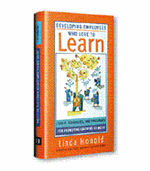Why did I choose this resource? 
I chose this resource to gain knowledge about incorporating learning into the workplace.
What did you learn from it?
I learned how important workplace learning is and many different ways of applying. I also learned the issues to address and steps to take when implementing it.
Key Knowledge
- The Importance of Learning
- Higher productivity and quality
- Competitive advantage
- Increased innovation
- Open communication
- Amplified employee attraction and retention
- More motivated employees
- Higher productivity and quality
- Characteristics of Learning in the Workplace
- Learning managed by the employee
- Knowledge of one’s learning style, values, beliefs, and interests
- Immediate learning when and where it is needed
- Solutions are not always known, experimentation used to solve a problem
- Many approaches to learning
- Unlearning (What was done wrong.)
- Learning and working go hand in hand
- Workplace Learning Issues
- Stages of Learning
- Stage 1 learners – unsure of their skills and need direction
- Stage 2 learners – not aware of what is important, but is self directed
- Stage 3 learners – understands their skills and have direction, but need help refining goals and finding new methods of learning
- Stage 4 learners – can plan, execute, and evaluate their own learning
- Context for Learning
- Formal – classroom, teacher
- Semiformal – conference room, group discussion lead by a facilitator
- Nonformal – planned but lead by the learners
- Informal – life experiences; experience, reflect, and recognize
- Styles of Learning
- The activist – open-minded, eager
- The pragmatist – problem solver
- The theorist – logical, analytical
- The reflector – cautious, observant
- Outcomes of Learning
- Cognitive / Knowledge – understanding
- Attitude / Values – perception
- Skill development – abilities
- Aspiration – goals
- Stages of Learning
- Designing / Implementing a Learning System
- Exploration
- Envisioning
- Planning
- Incubation and Development
- Implementation and Improvement
- Developing Self-Knowledge and Interest in Learning
- The Myers-Briggs Type Indicator
- Maslow’s hierarchy of needs
- Herzberg’s satisfiers and demotivators
- Core value chart
- Current skills inventory
- 360-degree feedback process
- Personal development plan
- Individual Learning
- Learning log / Journal
- Job shadowing
- Books / Audio tapes
- Self-study workbook
- Individual research projects
- Preparing public presentations
- Membership in organizations
- Attendance at conferences
- College-credit classes (In class or on the internet)
- One-on-One Learning
- Mentoring program – at least once a month – strategy
- Coaching session – one time or ongoing – specific task or skill
- Advisor or peer
- Group Learning
- Classroom
- Learning network
- Storyboarding
- Integrating Learning with Work
- Encourage and enable the team to learn through their daily activities
- Team projects
- Open book management meeting
- Mistakes
How are you using what you learned?
I am using what I learned to create a plan of the best ways to evaluate a person’s learning stage and with that information, how best to incorporate learning into our company.
Key Changes / Key Actions
- Create/Obtain a test for evaluating the learning stage.
- Research details of available learning tools and programs
Source
- summary.com: Developing Employees Who Love to Learn


